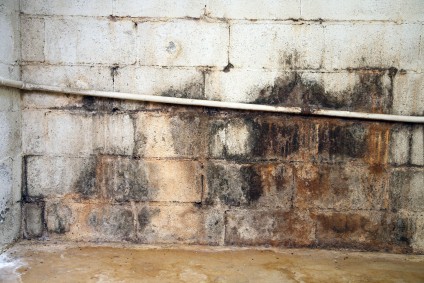We show you how to identify and spot damp in your house, and also what to do about it.
Damp proofing the walls of your house will protect the structure and the things inside your home, but will also save you and your family members a lot of hassle and money in the longer term!
This is having work done to your house and therefore preventing more serious damage happening to the building such as dry rot, ruined paintwork and damp infested furniture.
The signs of damp are often easy to spot because black mould spots appear on the walls, along with discolouration of internal paintwork, infestation in fabrics and curtain, and soggy (and smelly!) carpets.
How important is it to deal with damp once spotted?
The worse case scenario if you don’t deal with damp is the fact that you and your children will eventually become ill through living in a damp house.
Dampness and water ingress can also often be found behind wardrobes and sofas and in dark, enclosed spaces like the airing cupboard or a store under the stairs.

There are some things that you can do yourself to help damp proofing and damp removal and there are some things are best left to a contractor.
If you are planning on some home improvements this year, be sure to make your local contractor aware that your home has a damp problem, because this needs fixing before anything else is done.
How to identify if damp is coming in.
- Look at the air-bricks outside, which are bricks near to the ground with holes in them. They must not be blocked because air has to circulate under the floorboards.
- Check that your garden wall does not meet and touch the side of the house, because if it does, and no weatherproof strip was inserted where the garden wall meets the house wall, it will transmit damp into the house.
- Go outside and have a look to see if a path has been built right up next to the wall, but at a higher level than where the damp-proof course is. If this happens, then the DPC is breached and will allow water into the house. This can be remedied by cutting a line along the paths concrete, about an inch wide, and then putting a DPC felt strip between the path and the wall and then sealing it again, & be sure to leave a gap between the top of the strip and the wall.
- Examine your internal walls for: Wet or damp patches. Peeling wallpaper or even wet wall-paper, paint on the wall which powders when you run your finger over it. A smell like a wet dog (!). Black mould spores on the walls.
- Cracks both inside and outside are usually a sign something is wrong.
If in doubt, contact a reputable trade organisation such as the federation of master builders who can offer advice.
What ways can damp be cured?
There are several ways that damp in your house can be cured and they are:
- Damp Proof wall coatings or paints.
- Damp proofing silicone systems
- Osmotic systems such as the Schrijver system™
- Injected damp proof courses
- Waterproof wall render
So let’s look briefly at each method.
Oh and before I carry on, damp cannot be cured from inside the house, nor will opening a window solve the problem!
Damp proof wall coatings are a good solution to curing mouldy walls
Painting the walls outside may be a good way to make the house look nice, but if the fabric of the wall has problems, like damp or cracks, then your can of paint really will not do the job.
TOP TIP: MASONRY PAINT DOES NOT CURE DAMP!
Many home owners opt to kill two birds with one stone, although not literally, and purchase a damp proof wall coating, from a specialist firm.
The products sure looks akin to paint but it is specially formulated to deal with repelling the weather and whatever else is bringing moisture into the wall.
Many companies do a repair service before application, fixing missing render, cracked bricks or loose pebbledash, because these things all add up to making your wall like a sponge, and this means that it’s going to soak up the water.
The coatings allow the wall to breathe and flex naturally, whilst keeping the damp outside where it belongs. It can also make the scruffiest house look amazing.
Damp proofing clear coatings could be the solution
If you are having damp issues, but your home is made of unpainted brick or stone, then there are silicone type damp proof coatings that can cure that.
It is pointless me posting a photo as the coating does not alter what the house looks like!
Some repairs are carried out by the wall coating team and then it is spray applied in two coats, on a dry day, with a low pressure sprayer.
It is not to be confused with DIY products like Thompson’s waterseal™ because that product appears to sit ON TOP of the bricks and leaves a shine, whereas our damp proof clear coatings are absorbed into the wall, crystallising into a waterproof barrier within the wall.
And therefore it does not get affected by weather erosion like the Thompson’s product may do, plus our silicone system comes with a guarantee
Injected damp proof courses will cure rising damp but not penetrating damp
This is primarily to cure RISING damp and will do little to cure penetrating damp, i.e. damp coming in through the walls, rather than rising up from the ground.
The easiest and most effective way to to cure rising damp is to use a damp proofing kit which can be hired from most hire shops and contains several drums of damp-proof solution or cream, several tubes and suchlike, and of course the injection machine itself.
To effectively cure rising damp using a DPC machine, holes must be drilled to the lower part of the wall, both indoors and outside, at about 150mm above the floor level and about 75mm spaced apart.
Then the probe on the machine is inserted into each hole, which pumps the fluid into the house walls.
It is often best to leave the product to dry for about a month before you start any more works, although there are exceptions to the rule.
Our company ONLY installs this as part of a larger schedule of work
Waterproof render will also cure damp coming into the home
In most cases, rendering (known as “stucco” in the USA) is not waterproof when a normal sand and cement mixture is applied to a house.
There are some additives that you can buy, such as the items we saw on offer at popular building supplies website Twistfix.co.uk who offer a render admix for waterproofing for a shade under 20 quid.
I must say though, that this is only suitable for rendering a whole house, and depending on the size of the wall area, this can add a substantial extra cost to the rendering job.

The other alternative is coloured render such as the Never Paint Again type of rendering systems, which have a colour actually mixed into the render before it leaves the factory, so once through coloured render is applied to the wall, not only will it waterproof the wall, it won’t ever need painting either!
A user of the site sent us this email
….a user writes………..
“Hi, I have damp coming into my house, a little bit on the ground floor, below the bay window in the lounge, and 2 rooms upstairs feel very cold and when i moved the wardrobe back away from the wall, the wall itself had black mould on it.
Both rooms upstairs also feel freezing, despite the heater being on! Can you help?
From: Nigel, Manchester, UK
Why is my house damp ?
Hi Nigel, yes of course we could help you, it sounds very much like your home has a damp problem!
Although I’ll get one of surveyors to give you a call to discuss your particular house problems, if i may generalise for a minute to give you a background.
Firstly it sounds like your house has 2 kinds of dampness or water ingress
a) Rising damp, which sounds like the damp you have under your window, however without looking at it in person its difficult to be exact!
It may be also a bad seal around the window, a loose or missing slate from the bay, or a crack outside, a loose or missing piece of rendering or pebbledash coating etc, but again, we have to see it to be sure (which is a free service by way).
What it COULD be though is RISING DAMP.
This means that somewhere the DPC (damp proof course, the strip of bituminous felt that is laid on the lower bricks when they built the house, to stop the water from the ground rising up into the house), and this can be easily and permanently cured by injecting a chemical DPC which is a resin that is injected into the walls.
This should cure it no problem, but again, we really do need to see the house to be 100% sure.
b) Penetrating damp, which sounds like what you have in your upstairs rooms, although again, we do need to see the place!!!!!!!! (We would save a lot of money as a company if we could give exact quotes out over the phone!).
The black mould can be harmful to you also so 1stly go to a DIY store and get some anti damp paint or treatment, wash the wall and get rid of the mould, then treat it, however I would err on the side of caution here as the damp you have in those rooms would suggest an underlying problem outside.
The tips i have given you probably wont cure the damp permanently so again, give us a call later and we’ll send someone round, we have a surveyor who lives only a few streets away in fact so its not a problem to take a quick look. Speak later and thanks again for your question………..
G Bell
www.neverpaintagain.co.uk
So there we are, how to damp proof your house!
We are always on hand to offer FREE advice, so if your house has damp, of you THINK it may have damp or water ingress, please get in contact with us today on (0800) 970 4928, we would love to hear from you.

